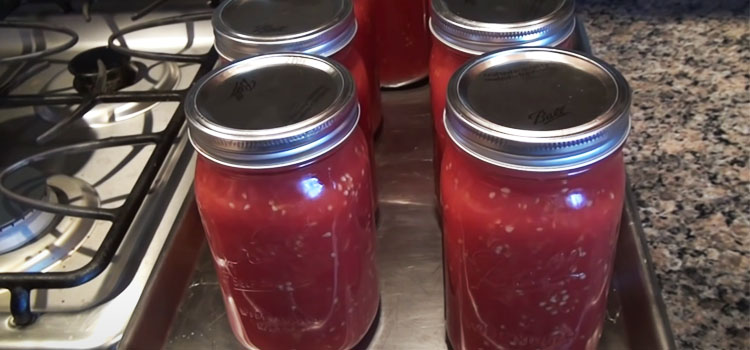Last Updated on July 17, 2024 by Shari Mason
Are you intrigued by what transpires following the canning procedure? What occurs once you have proficiently packed and preserved your jars?
If you’re also curious as to how long it takes for canning jars to seal, you’re not alone.
Let me provide my insights based on experience and clarify how long it typically takes for canning jars to achieve that satisfying, airtight seal that signals successful preservation.
How Long Should I Wait For A Canning Jar To Seal?


After the canning process [1], allow your jars to cool naturally for 12 to 24 hours before checking for a seal. During this time, the lids gradually form a vacuum seal as the contents cool and contract.
Resisting the urge to rush this crucial step ensures the sealing process occurs naturally and effectively.
“Cooking is like painting or writing a song. Just as there are only so many notes or colors, there are only so many flavors – how you combine them sets you apart.”
– Wolfgang Puck, Chef
This waiting period ensures that your preserved goods are safely and securely sealed, ready to be stored confidently.
But do jars have to be fully submerged when canning?
What Does A Good Seal Look Like?
A good seal is easily identifiable by a concave lid that appears slightly indented in the center. When you run your fingers over the lid, you might feel a gentle depression.
This concavity indicates that the vacuum created during the cooling process has successfully sealed the jar.
While the audible “ping” can be reassuring, the visual confirmation of the lid’s concave shape is a reliable sign that your canning efforts have yielded a securely sealed jar, ready to protect and preserve its contents until you’re ready to savor them.
But is vacuum sealing similar to canning?
Is It Normal For Sealing Times To Vary?
Yes, it’s entirely normal for sealing times to vary when canning. Factors such as altitude [2], the type of food being canned, and the size of the jars can all influence the timing of the sealing process.
Higher altitudes lead to quicker sealing due to lower atmospheric pressure, while larger jars could take longer to cool and create a vacuum seal.
Additionally, certain foods might release more steam during processing, affecting the time for the lids to seal securely.
These variations are part of the dynamic nature of canning, and understanding them empowers you to adapt and ensure successful preservation regardless of the unique circumstances.
Read:
- What Happens If You Forgot To Put Lemon Juice In Canned Tomatoes?
- How To Wash Mason Jar Lids In Dishwasher?
- Can You Reuse Pasta Sauce Jars For Canning?
Can I Speed Up The Sealing Process?


While the sealing process is best allowed to occur naturally, there are steps you can take to help facilitate it without compromising the integrity of the seal.
Once your jars are removed from the canner and placed on a towel or wooden surface, you can gently press down on the center of the cooled lids.
This light pressure can aid in expelling residual air and help the lids create a vacuum seal. However, it’s essential to exercise caution and avoid excessive force, as this can interfere with the natural cooling and sealing process.
Balancing gentle encouragement with patience ensures that you support the sealing process while maintaining the quality of your canned goods.
But can you also use a canning pot when cooking?
What If A Jar Doesn’t Seal?
If a jar has yet to be sealed within 24 hours of processing, there’s no need to fret. While sealed jars typically display a concave lid and emit the satisfying “ping” sound, unsealed jars can still be salvaged.
First, check the sealing surface and rim for any food particles or residue that might prevent a proper seal. Clean the rim thoroughly and replace the lid with a new, sterilized one.
“The seal is more than just a lid—it’s a promise that time and patience have collaborated to preserve nature’s bounty. As lids whisper their ‘ping’ and jars embrace their airtight embrace, the flavors of patience and anticipation meld into the sweet satisfaction of successful preservation.”
– Eat Pallet Restaurant & Food Advice
Reprocess the jar according to the recommended canning guidelines. Alternatively, if reprocessing isn’t feasible, refrigerate the contents for short-term use or enjoy them promptly.
FAQs
u003cstrongu003eHow long do you leave jars in boiling water to seal?u003c/strongu003e
The time for jars to boil in water to achieve a seal varies based on altitude and jar size, but it typically ranges from 10 to 20 minutes.
u003cstrongu003eCan jars seal without popping?u003c/strongu003e
Yes, jars can seal without making an audible popping sound. The absence of a u0022popu0022 doesn’t necessarily indicate a failed seal; instead, look for the concave lid and firmness to the touch as signs of successful sealing.
Key Takeaways
The sealing phase of canning is a blend of science and patience. While the specific duration for jars to seal varies based on altitude, jar size, and contents, the waiting game is worth the flavorful reward.
As lids cool and the magic of vacuum sealing occurs, anticipating that satisfying “ping” or seeing a concave lid symbolizes successful preservation.
Embracing the art of timing and understanding the dynamics of sealing ensures that your canning endeavors yield beautifully sealed jars that testify to your dedication and skill in food preservation.
References:
- https://www.britannica.com/topic/canning-food-processing
- https://education.nationalgeographic.org/resource/altitude
- How to Cancel a Pizza Hut Order? Quick & Easy Guide - July 26, 2024
- How Long Do I Cook a DiGiorno Pizza? Perfect Timing Tips - July 26, 2024
- What Kind of Advertising Do Restaurants Use? - July 24, 2024

